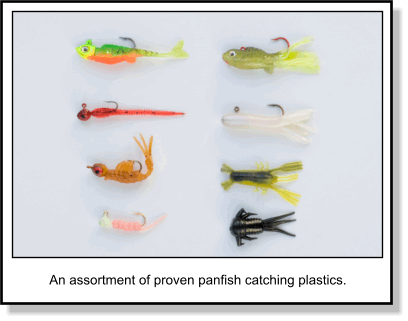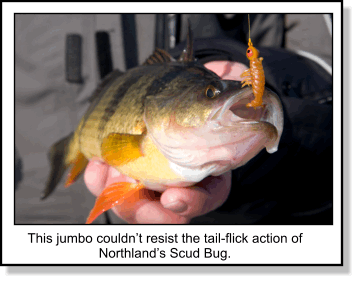|
 Persuasive
Panfish Plastics Persuasive
Panfish Plastics
By Tim Allard*
Soft-plastics are becoming fan favourites with hard-water panfish
stalkers. Lifelike profiles, irresistible actions, and durability
are a sampling of the reasons whey more anglers are opting to use
artificials instead of live bait. Perch, crappie and sunfish can be
tempted into slurping in soft-plastics whether aggressively feeding
or inactive.
Persuasive on Perch
A curious lot, yellow perch often fall victim to soft-plastics.
Minnows, tubes,
 and various buggy specimens in the 1.5- to 2-inch
range are common baits. Iím a long-time fan of Berkleyís Atomic
Teaser Tubes for jigging both suspending and bottom-hugging perch.
The spiral decent of these baits is especially effective at both
attracting these fish and seducing them to strike. Two other
noteworthy invertebrate imitators thatíll catch perch and other panfish are the Mister Twister Micro Mania Nymph and Micro Crawfish. and various buggy specimens in the 1.5- to 2-inch
range are common baits. Iím a long-time fan of Berkleyís Atomic
Teaser Tubes for jigging both suspending and bottom-hugging perch.
The spiral decent of these baits is especially effective at both
attracting these fish and seducing them to strike. Two other
noteworthy invertebrate imitators thatíll catch perch and other panfish are the Mister Twister Micro Mania Nymph and Micro Crawfish.
Scud-Struck
A new star in my panfish jigging line-up is the Northland Scud Bug.
The baitís profile is designed to mimic freshwater shrimp, or scuds,
which are a frequent menu item for perch in winter. In addition to a
realistic profile, the plastic also features a hinged tail that
flutters and kicks with the slightest rod tip quiver. This flapping
appendageís highly potent at triggering hits from fish.

Working the Water Column
When fishing plastics I swim the offering down the water
column to try and attract fish in the area. After it reaches bottom
I snap the rod with a few short lifts to bang the floor a couple
times. This creates a silt cloud and is a sure-fire tactic to
attract perch and other panfish. Then I raise the jig up by foot
increments back to the surface, working in pauses and the occasional
back-step. If I donít mark any other fish, or Iíve caught the biters
out of the area, itís on to the next hole.
Functionality in Frigid Conditions
Another selling point of soft-plastics is that you donít
need to babysit them like live bait, which is particularly a benefit
in extremely cold. Bitter temperatures are common in midwinter, a
period notorious for inactive fish. The knee-jerk reaction when
dealing with fussy panfish is using a maggot or a waxworm tipped
jig. Unfortunately, in nasty winter conditions live bait left on a
lure when hole-hopping in search of biters will quickly freeze,
eliminating its appeal. Frozen live bait requires re-baiting,
causing fishing downtime and frozen fingers. Soft-plastics are more
efficient and just as effective way to finesse fish.
Persuasive Profiles
Itís not just the anti-freeze trait that makes these
springy artificials effective for winter crappie. Todayís products
are extremely subtle and deliver a fluid, natural action when
jigged. Moulding techniques have evolved to produce extremely
lifelike baits that imitate a range of buggy organisms panfish
frequently dine on. Additionally, some soft-plastics arenít designed
with flawless realism as the objective. Instead these baits are more
akin to genetically engineered super-food and loaded with finesse
features, such as added scent, to coerce hits from snobby panfish.
 A
Spectrum of Hues A
Spectrum of Hues
Another benefit is baits come in an array of coolers. I
prefer a white, glow, or hot coloured bait to trigger bites from
fussy customers inhabiting dark waters. In clear water natural hues
(red, brown, black, and green) can be quite productive. Two-tone
patterns as well as infused glitter also boosts the edge plastics
have over the plain patterns of live bait.
Tantalizing Tails
Hard-baits have flash, roll and rattles, but they canít
compete with a soft-plasticís tail when it comes to a natural
swimming action. The motion of this appendage is one of the biggest
advantages of plastics. This applies to many species, but the wispy
micro tail of a micro plastic is particularly lethal at fooling
sunfish.
Witnessing a bait-bluegill standoff when sight-fishing is nerve
wracking. When inactive, these fish will scrutinize baits worse than
a ill tempered food critic. Presentation and profile must be
flawless. Micro-plastics are frequently the miracle meal.
Deadly for Droppers
Soft-plastics also work on a myriad of dropper rigs. A
small worm, bug, or minnow are excellent baits to tip a drop shot
hook or to dress a dropper line dangling beneath a spoon or ice jig.
Unlike live bait that can quickly be picked away by panfish,
plastics are more resilient and stay on a hook longer. This gives
anglers more time in the strike zone with an effective presentation
to try and tempt fussy customers.
Soft-plastics can conjure up bites from even the most subdued
panfish in winter. There are plenty of products available on the
market, so be sure to try these pliable baits this ice season.
*Tim Allard of Ottawa, Ontario is a
hard-water expert and author-photographer of the newly released
book, Ice Fishing: The Ultimate Guide. For more information visit:
www.helipress.com/product/ice-fishing-138.cfm
Editors & Publishers
T.J. & Monique Quesnel
|
The
Ontario Fishing Network
E-Magazine is
published 12 times a year on or near the beginning of every month. Our
magazine is geared to any angler who enjoys fishing of any type in the
wonderfully diverse province of Ontario. Editorial Submissions: We welcome query letters,
but assume no responsibility for unsolicited materials. Subscriptions: Subscriptions are FREE of charge
and delivered via email.
You can subscribe
HERE: Privacy Policy: Unlike other publications We
NEVER make our subscribers list (your email address) available to any
other companies. Advertising: If you are interested in advertising
please email us. Circulation - 12,000 email subscribers
© 2010 Due North
Marketing / Ontario Fishing Network / T.J. Quesnel. All rights
reserved. Reproduction of any material without prior written
permission strictly prohibited. |
|